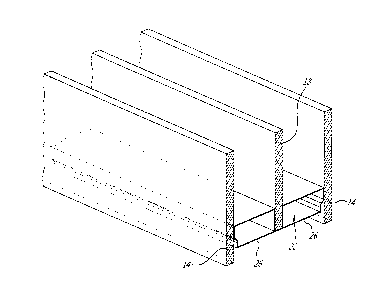Some of the information on this Web page has been provided by external sources. The Government of Canada is not responsible for the accuracy, reliability or currency of the information supplied by external sources. Users wishing to rely upon this information should consult directly with the source of the information. Content provided by external sources is not subject to official languages, privacy and accessibility requirements.
Any discrepancies in the text and image of the Claims and Abstract are due to differing posting times. Text of the Claims and Abstract are posted:
| (12) Patent Application: | (11) CA 2876598 |
|---|---|
| (54) English Title: | STAINED GLASS ASSEMBLY FOR DOORS, WALL PARTITIONS OR THE LIKES |
| (54) French Title: | ENSEMBLE DE VITRAUX POUR PORTES, DIVISEURS MURAUX ET AUTRES SEMBLABLES |
| Status: | Deemed Abandoned and Beyond the Period of Reinstatement - Pending Response to Notice of Disregarded Communication |
| (51) International Patent Classification (IPC): |
|
|---|---|
| (72) Inventors : |
|
| (73) Owners : |
|
| (71) Applicants : |
|
| (74) Agent: | AGENCE DE BREVETS FOURNIER |
| (74) Associate agent: | |
| (45) Issued: | |
| (22) Filed Date: | 2015-01-06 |
| (41) Open to Public Inspection: | 2016-07-06 |
| Examination requested: | 2018-11-29 |
| Availability of licence: | N/A |
| Dedicated to the Public: | N/A |
| (25) Language of filing: | English |
| Patent Cooperation Treaty (PCT): | No |
|---|
| (30) Application Priority Data: | None |
|---|
A stained glass assembly includes at least two adjacent flat pieces of
material
received on two opposite side thereof in retaining channels and a spacer
element in each retaining channel between each pair of the at least two
adjacent flat pieces of material so as to create an opened gap therebetween.
Such a stained glass assembly can be used as a decorative window in a door
or as a baffle wall for example.
Note: Claims are shown in the official language in which they were submitted.
Note: Descriptions are shown in the official language in which they were submitted.

2024-08-01:As part of the Next Generation Patents (NGP) transition, the Canadian Patents Database (CPD) now contains a more detailed Event History, which replicates the Event Log of our new back-office solution.
Please note that "Inactive:" events refers to events no longer in use in our new back-office solution.
For a clearer understanding of the status of the application/patent presented on this page, the site Disclaimer , as well as the definitions for Patent , Event History , Maintenance Fee and Payment History should be consulted.
| Description | Date |
|---|---|
| Inactive: Adhoc Request Documented | 2021-03-23 |
| Inactive: Office letter | 2021-03-23 |
| Application Not Reinstated by Deadline | 2021-03-05 |
| Inactive: Dead - No reply to s.86(2) Rules requisition | 2021-03-05 |
| Revocation of Agent Request | 2021-02-22 |
| Change of Address or Method of Correspondence Request Received | 2021-02-22 |
| Appointment of Agent Request | 2021-02-22 |
| Letter Sent | 2021-01-06 |
| Common Representative Appointed | 2020-11-07 |
| Deemed Abandoned - Failure to Respond to an Examiner's Requisition | 2020-03-05 |
| Examiner's Report | 2019-11-05 |
| Common Representative Appointed | 2019-10-30 |
| Common Representative Appointed | 2019-10-30 |
| Inactive: Report - No QC | 2019-10-23 |
| Letter Sent | 2018-12-03 |
| Request for Examination Received | 2018-11-29 |
| Request for Examination Requirements Determined Compliant | 2018-11-29 |
| All Requirements for Examination Determined Compliant | 2018-11-29 |
| Inactive: Cover page published | 2016-08-03 |
| Application Published (Open to Public Inspection) | 2016-07-06 |
| Inactive: IPC assigned | 2015-02-20 |
| Inactive: IPC assigned | 2015-02-20 |
| Inactive: First IPC assigned | 2015-02-18 |
| Inactive: IPC assigned | 2015-02-18 |
| Inactive: IPC assigned | 2015-02-17 |
| Inactive: IPC assigned | 2015-02-17 |
| Inactive: Filing certificate - No RFE (bilingual) | 2015-01-14 |
| Application Received - Regular National | 2015-01-09 |
| Inactive: QC images - Scanning | 2015-01-06 |
| Inactive: Pre-classification | 2015-01-06 |
| Abandonment Date | Reason | Reinstatement Date |
|---|---|---|
| 2020-03-05 |
The last payment was received on 2019-12-09
Note : If the full payment has not been received on or before the date indicated, a further fee may be required which may be one of the following
Patent fees are adjusted on the 1st of January every year. The amounts above are the current amounts if received by December 31 of the current year.
Please refer to the CIPO
Patent Fees
web page to see all current fee amounts.
| Fee Type | Anniversary Year | Due Date | Paid Date |
|---|---|---|---|
| Application fee - standard | 2015-01-06 | ||
| MF (application, 2nd anniv.) - standard | 02 | 2017-01-06 | 2016-11-23 |
| MF (application, 3rd anniv.) - standard | 03 | 2018-01-08 | 2017-10-18 |
| MF (application, 4th anniv.) - standard | 04 | 2019-01-07 | 2018-11-29 |
| Request for examination - standard | 2018-11-29 | ||
| MF (application, 5th anniv.) - standard | 05 | 2020-01-06 | 2019-12-09 |
Note: Records showing the ownership history in alphabetical order.
| Current Owners on Record |
|---|
| VITRE-ART INC. |
| Past Owners on Record |
|---|
| NICOLAS BARAZIN |